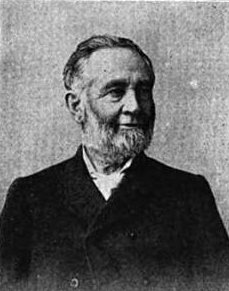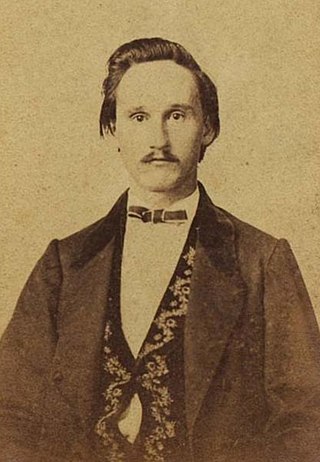The Battle of Bayou Fourche, also known as the Battle of Little Rock, was a battle of the American Civil War fought between Union and Confederate forces on September 10, 1863, in Pulaski County, Arkansas. It was the final battle of the Little Rock Campaign, resulting in the Federal occupation of Little Rock.

The Battle of Clark's Mill was fought on November 7, 1862, near Vera Cruz, Missouri, as part of the American Civil War. Confederate troops led by Colonels Colton Greene and John Q. Burbridge were recruiting in the Gainesville area. Union Captain Hiram E. Barstow commanded a detachment at Clark's Mill near Vera Cruz, and heard rumors of Confederate depredations around Gainesville. In response, Barstow sent patrols towards Gainesville and Rockbridge, personally accompanying the latter. Confederate forces were encountered before reaching Rockbridge, and Barstow fell back to Clark's Mill. The Confederates arrived from multiple directions, and after a skirmish of five hours, surrounded the Union position. With night falling, the Confederates offered Barstow surrender terms that were accepted. The Union soldiers were paroled and their blockhouse destroyed; both Barstow and the Confederates left the area after the skirmish. A Union counterstroke left Ozark the next day.

The Second Battle of Independence was fought on October 22, 1864, near Independence, Missouri, as part of Price's Raid during the American Civil War. In late 1864, Major General Sterling Price of the Confederate States Army led a cavalry force into the state of Missouri, hoping to create a popular uprising against Union control, draw Union Army troops from more important areas, and influence the 1864 United States presidential election.

The Battle of Little Blue River was fought on October 21, 1864, as part of Price's Raid during the American Civil War. Major General Sterling Price of the Confederate States Army led an army into Missouri in September 1864 with hopes of challenging Union control of the state. During the early stages of the campaign, Price abandoned his plan to capture St. Louis and later his secondary target of Jefferson City. The Confederates then began moving westwards, brushing aside Major General James G. Blunt's Union force in the Second Battle of Lexington on October 19. Two days later, Blunt left part of his command under the authority of Colonel Thomas Moonlight to hold the crossing of the Little Blue River, while the rest of his force fell back to Independence. On the morning of October 21, Confederate troops attacked Moonlight's line, and parts of Brigadier General John B. Clark Jr.'s brigade forced their way across the river. A series of attacks and counterattacks ensued, neither side gaining a significant advantage.

Price's Missouri Expedition, also known as Price's Raid or Price's Missouri Raid, was an unsuccessful Confederate cavalry raid through Arkansas, Missouri, and Kansas in the Trans-Mississippi Theater of the American Civil War. Led by Confederate Major General Sterling Price, the campaign aimed to recapture Missouri and renew the Confederate initiative in the larger conflict.
Joseph Chrisman Porter was a Confederate officer in the American Civil War, a key leader in the guerrilla campaigns in northern Missouri, and a figure of controversy. The main source for his history, Joseph A. Mudd is clearly an apologist; his opponents take a less charitable view of him, and his chief adversary, Union Colonel John McNeil, regarded him simply as a bushwacker and traitor, though his service under General John S. Marmaduke in the Springfield campaign and following clearly shows he was regarded as a regular officer by the Confederacy.

The 1st Iowa Cavalry Regiment was a cavalry regiment that served in the Union Army during the American Civil War.

The Skirmish at Island Mound was a skirmish of the American Civil War, occurring on October 29, 1862, in Bates County, Missouri. The Union victory is notable as the first known event in which an African-American regiment engaged in combat against Confederate forces during the war.
The Enrolled Missouri Militia was a state militia organization of Missouri in 1862 during the American Civil War. It was a part-time force whose primary purpose was to serve as garrison and infrastructure guards, both to augment the Unionist Missouri State Militia in defense versus raids and to free the Missouri State Militia for offensive operations versus Confederate guerrillas and recruiters.

Odon Guitar was a general in the Union Missouri State Militia during the American Civil War. He was noted for his successful campaign against Joseph C. Porter and John A. Poindexter's recruiting commands in northern Missouri.
The Battle of Moore's Mill was an American Civil War battle that took place in Central Missouri on July 28, 1862 along Auxvasse Creek near modern-day Calwood. This engagement, the Battle of Kirksville a week later, and the Battle of Compton's Ferry would drive the main Southern recruiters from northern Missouri. The Moore's Mill Battlefield was added to the National Register of Historic Places in 2015.
The Missouri State Militia was a federally funded state militia organization of Missouri conceived in 1861 and beginning service in 1862 during the American Civil War. It was a full-time force whose primary purpose was to conduct offensive operations against Confederate guerrillas and recruiters as well as oppose raids by regular Confederate forces. The militia at one time numbered more than 13,000 soldiers, but this force was reduced to 10,000 soldiers, by the United States government.
John A. Poindexter was a colonel in the Confederate Army during the American Civil War. He and Joseph C. Porter were the primary recruiting commanders in northern Missouri during 1862.
The Battle of Compton's Ferry, also known as Little Compton Ferry, was an action during the American Civil War, occurring along the Grand River in southwest Livingston County, Missouri. The battle lasted from August 10 to August 13, 1862.

The 10th Arkansas Infantry (1861–1865) was a Confederate Army infantry regiment during the American Civil War from the state of Arkansas. The unit is also known as A. R. Witt's Infantry, C. M. Cargile's Infantry, E. L. Vaughan's Infantry, Thomas D. Merrick's Infantry, S. S. Ford's Infantry, Obed Patty's Infantry, George A. Merrick's Infantry, Zebulon Venable's Infantry and Robert C. Bertrand's Infantry in contemporary accounts. After being captured at the Siege of Port Hudson, the unit reorganized as a mounted infantry unit, and was known as the 10th Arkansas Cavalry Regiment or Witt's Arkansas Cavalry.
The 2nd Missouri Cavalry Regiment, also known officially as Merrill's Horse, was a cavalry regiment that served in the Union Army during the American Civil War. The regiment was one of only a handful of Missouri regiments to be officially named as well as numbered.
Benjamin Franklin Gordon, commonly known as B. Frank Gordon, was a Confederate States Army colonel during the American Civil War. Gordon had been a private and bugler for a Missouri regiment serving in the U.S. Army during the Mexican–American War. Gordon served in the Confederate Army under Brigadier General Joseph O. "Jo" Shelby in Missouri and Arkansas in the Confederate Trans-Mississippi Department throughout the war. On May 16, 1865, with the war coming to an end, General E. Kirby Smith, as the Confederate commander of the Trans-Mississippi Department, assigned Gordon to duty as a brigadier general. The Confederate government took no action on the appointment and Confederate President Jefferson Davis did not officially appoint and nominate Gordon to the rank of brigadier general because the Confederate Senate last met on March 18, 1865, and Davis was captured by Union troops on May 10, 1865. Although he was only aged 40 at his death, Gordon survived the war by little more than a year.

7th Missouri Cavalry Regiment was a cavalry unit from Missouri that served in the Union Army during the American Civil War. The regiment was formed on 20 February 1862 by merging Bishop's Cavalry Battalion with some unattached cavalry companies. The regiment fought at Independence, Lone Jack, Prairie Grove and Van Buren in 1862. The unit participated in Frederick Steele's expedition to Little Rock in 1863, fighting at Brownsville, Ashley's Mills, and Bayou Fourche. In 1864, the regiment went on the Camden Expedition and fought at Mount Elba and Marks' Mills. The remaining soldiers were consolidated with the 1st Missouri Volunteer Cavalry Regiment on 22 February 1865.
The 10th Texas Field Battery was an artillery battery that served in the Confederate States Army during the American Civil War. After being formed in early 1861 by Benjamin H. Pratt, the battery served with a cavalry formation led by Colonel William Henry Parsons for part of 1862. It was called upon to enter Missouri in support of troop movements related to the Battle of Prairie Grove, but this did not occur. It then operated along the Mississippi River in early 1863, harassing enemy shipping. The unit then participated in Marmaduke's Second Expedition into Missouri and the Battle of Pine Bluff in 1863. Late in 1864, the battery, now under the command of H. C. Hynson, served in Price's Raid, participating in several battles and skirmishes, including the disastrous Battle of Mine Creek. One source claims the unit's service ended on May 26, 1865, while a Confederate report dated June 1, 1865, states that it existed but did not have cannons. Confederate forces in the Trans-Mississippi Department surrendered on June 2.
Bazel Ferdinand Lazear (1823–1894) held the rank of Lieutenant colonel in the Missouri State Militia during the American Civil War. His service spanned multiple militia units from 1861 to 1865 before he assumed command of the 1st Regiment Missouri State Militia. Notably, he led this regiment from July to September 1864, participating in key engagements including Shelby's Raid, the Second Battle of Independence, the Battle of Mine Creek, the Battle of Westport, and the Battle of Byram's Ford.








